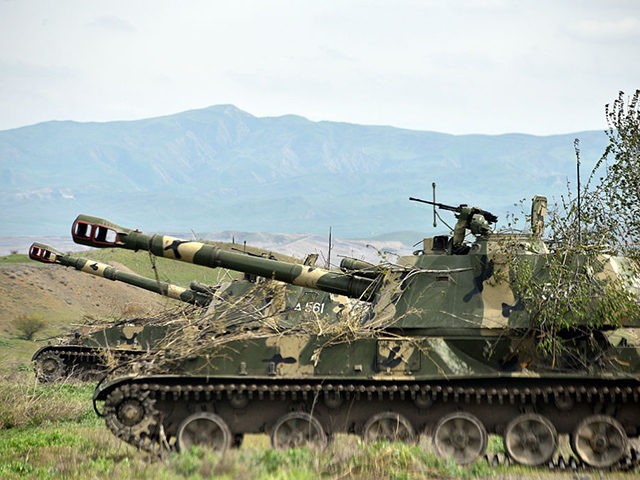Armenia and Azerbaijan reported casualties on Sunday following clashes between their militaries in the disputed region of Nagorno-Karabakh — The two countries accused each other of initiating the conflict.
Both Armenia and Azerbaijan declared martial law following the fighting, which reportedly killed at least 23 people.
Nagorno-Karabakh is a region located along the disputed border separating Azerbaijan and Armenia. In the 1990s, ethnic Armenian separatists seized the region from Baku in a war that killed at least 30,000 people.
Sunday’s fighting continued into Monday morning “with heavy artillery used by both sides,” according to Abu Dhabi-based newspaper the National. “The Armenian defense ministry reported fighting throughout Sunday night, while its counterpart in Azerbaijan said Armenian forces were shelling the town of Terter.”
Arayik Harutyunyan, president of the self-proclaimed Nagorno-Karabakh Republic (Artsakh), said that “seventeen Armenian separatist fighters were killed and more than 100 wounded in the fighting,” according to the newspaper. Harutyunyan conceded that “his forces had lost positions” in Sunday’s fighting.
Azerbaijan’s Prosecutor-General’s Office said that 19 civilians were wounded on Sunday in shelling by Armenian armed forces, Radio Free Europe (RFE) reported.
Armenian Defense Ministry spokesman Artsrun Hovhannisian said that “Azerbaijani forces launched missile attacks along the Line of Contact [the regional border separating Armenian and Azerbaijani forces] and said civilians and civilian infrastructure in Stepanakert had been targeted,” according to the report.
“There has been significant damage to buildings in certain parts of Nagorno-Karabakh and Stepanakert,” Hovhannisian said at a press conference.
The newly erupted fighting between Muslim Azerbaijan and Christian-majority Armenia called the attention of regional players Russia and Turkey on Sunday. Russia regards Armenia as a strategic partner, while Turkey considers Azerbaijan a close regional ally, as Azerbaijanis are an ethnically Turkic people. The Turkish government traditionally sides with Azerbaijan against Armenia in regional conflicts. Turkey’s government also committed the first genocide in modern history against the Armenian people, though it continues to officially deny that the mass killings occurred.
Russian President Vladimir Putin discussed the border dispute with Armenian Prime Minister Nikol Pashinyan in a phone call on Sunday.
“[T]he conversation noted that it was important not to allow further escalation of the conflict, and emphasized the need to halt all military action,” Sky News reported.
Also on Sunday, Azerbaijani Foreign Minister Ceyhun Bayramov spoke by phone with Russian Foreign Minister Sergei Lavrov about the conflict. Lavrov “expressed concern about the situation in the region and ‘stressed the urgency of restoring ceasefire regime,'” according to RFE.
“The Turkish people will support our Azerbaijani brothers with all our means as always,” Turkish President Recep Tayyip Erdoğan tweeted.
Armenia’s Foreign Ministry claimed on Monday that “Turkey sent military experts, drones, and warplanes to reinforce Azerbaijan” in its conflict with Armenia over their disputed territory.
“The Armenian parliament accused Turkey of interfering in the conflict, which Azerbaijan denied,” the National, reported on Monday.
Prior to Sunday’s fighting, Armenia and Azerbaijan’s border conflict most recently flared up in July in the Tavush region, less than two hundred miles from Nagorno-Karabakh. As Breitbart News reported at the time, the two countries’ troops exchanged fire, killing at least 16 soldiers on both sides. The cause for the violent outburst was unclear, though Azerbaijan accused Armenia’s military of attacking first.
Following the clash, Azerbaijan’s Defense Ministry spokesman, Vagif Dargahli, threatened to bomb the Armenian (Metsamor) Nuclear Power Plant, described as one of “the world’s most dangerous” nuclear plants due to its risky location in an active earthquake zone. Metsamor is also considered hazardous due to its lack of modern containment safeguards.
“The Armenian side must not forget that our army’s state-of-the-art missile systems allow us to strike the Metsamor nuclear plant with precision, which could lead to a great catastrophe for Armenia,” Dargahli said on July 16.
Metsamor is located just 22 miles from Armenia’s capital, Yerevan, near Armenia’s Turkish border.

COMMENTS
Please let us know if you're having issues with commenting.